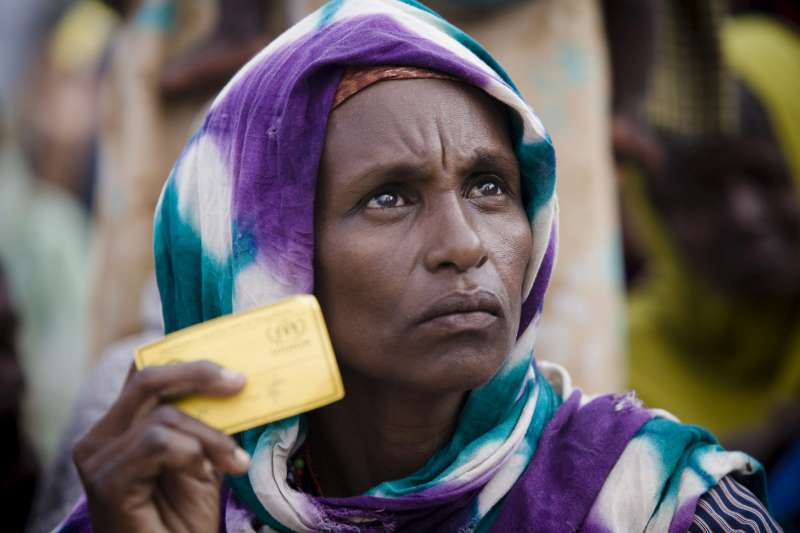From Dublin to Dadaab: Life in an East African refugee camp
25 November 2013
In 2008, Dublin native, Andy Needham, left a successful career in corporate PR to work as a UNHCR External Relations Officer at the world’s largest refugee camp, Dadaab in Kenya. It was a considerable change but one which he has no regrets about making. Since then he hasn’t looked back and is now 
1. What attracted you to working with UNHCR?
I joined the Irish Aid Rapid Response Corps (RRC) in 2007, did my training and was deployed with UNHCR Kenya for the 2008 post-election violence IDP (internally displaced people) emergency as a reporting officer. I was previously a journalist and public relations officer in Ireland. To be honest I don't think I was really aware of UNHCR and didn't expect to be deployed with them. I was sent for three months initially and I'm still with UNHCR over five years later.
2. Do you consider it rewarding work?
It's extremely rewarding. I used to think at the time that the stuff I did for clients when I worked in PR was important, interesting and exciting but it kind of pales into insignificance when compared to working in a refugee camp, for example. I don't think I would ever want to return to an 'ordinary' job behind a desk. 
Image: Aid items are unloaded from a truck at the Al Adala settlement, Somalia, 2011 © UNHCR/S.Modola
3. How long have you been based in Somalia and did you have any previous posting with UNHCR? If so, how do they compare?
I have been with the Somalia operation since May 2010 as Executive Assistant to the Representative and Public Information Officer (up to April of this year as an Irish Aid deployee). Before that I spent over a year as External Relations Officer in Dadaab refugee camp in north eastern Kenya, close to the Somali border and before that a year on the Kenya IDP operation. Right now, I'm on a two month emergency mission as Press Officer in Za'atri camp, Jordan for Syrian refugees, which is close to the Syria border. Za'atri is very similar in many respects to my time in Dadaab - lots of media and donor missions to deal with. The Somalia operation is perhaps one of the most complex and challenging and working on the 2011 famine emergency response is an experience that I will never forget.

4. What is the most immediate challenge for UNHCR working in Somalia?
Access to a number of areas for humanitarian workers and security issues has always been an issue inside Somalia. At the moment, UNHCR is in dialogue with the Kenyan and Somali governments in relation to what's known as a tri-partite agreement to frame the process for returns of Somali refugees in line with all international human rights law principles and when the time is right to do so in terms of security, services and infrastructure in areas of origin and return in Somalia - [subsequent to this interview the Agreement was signed]. This process would inform and be a template for all other agreements with governments in neighbouring countries hosting Somali refugees.
Image: Refugees waiting to be registered sit in front of the UNHCR registration offices at Dadaab camp, 2010 © UNHCR/E.Hockstein
5. Could you give me a brief description of your day-to-day work?
I'm the Associate Public Information and Communications Officer for UNHCR Somalia. Due to operational reasons, I am based in Nairobi at present but we are 'migrating' to Mogadishu and other offices in Somalia next year. As well as the usual media queries and communications meetings in Nairobi, we do a lot of video reports, web stories and briefing notes in the Somalia operation so that takes up a lot of our effort as it is not easy to undertake missions in the field. However, we just produced a 26 minute documentary on the 2003 Nansen Refugee Award winner, Annalena Tonelli, who was murdered in Somaliland just months after receiving the award 10 years ago. Similarly, we successfully nominated Mama Hawa Aden Mohamed for the 2012 Nansen Refugee Award and that meant a very busy year of work for us. We are also occupied with the issue of proposed refugee returns from the region.
6. Why, in your view, is Ireland's financial support to UNHCR so important? 
Despite the economic changes in recent years, Ireland continues to provide significant funding to UNHCR operations around the world. I was involved in the mission of the Tanaiste and Minister for Foreign Affairs to Mogadishu last year when he announced funding of Euro 500,000 to provide shelter and other assistance to IDPs. This maintains the long-established link between Ireland and UNHCR and Ireland remains among the top donors relative to GDP to UNHCR.
Image: An internally displaced Somali woman, holding her registration card, waits for humanitarian supplies flown to Mogadishu by UNHCR. © UNHCR/S.Modola
7. What do you miss most about home?
I'm from Dublin but have been away so long now that I probably think of Nairobi as my home at this stage. I certainly don’t miss the Irish weather! A creamy pint of Guinness in Hourican's and the buffalo wings in Elephant & Castle. That's about it. Sorry Mam! Just kidding, of course I miss the Mammy and my family and friends and will hopefully get to see them all next year on my home leave. It's my Mam's 80th birthday in June and I hope to be there to celebrate it with all of the above.
By: Alana Ryan







